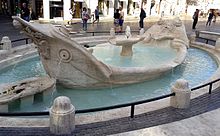| Revision as of 09:27, 12 October 2017 editCote d'Azur (talk | contribs)Extended confirmed users137,911 edits ce← Previous edit | Revision as of 13:33, 11 March 2018 edit undoMattes (talk | contribs)Extended confirmed users1,670 editsm rm "ugly"Next edit → | ||
| Line 2: | Line 2: | ||
| ].]] | ].]] | ||
| The '''Fontana della Barcaccia''' (''Fountain of the |
The '''Fontana della Barcaccia''' (''Fountain of the Boat''; {{IPA-it|barˈkattʃa}}) is a ]-style fountain found at the foot of the ] in ]'s ] (Spanish Square). ] commissioned ] in 1623 to build the fountain as part of a prior Papal project to erect a fountain in every major piazza in Rome. The fountain was completed between 1627 and 1629 by Pietro possibly along with the help of his son ], especially after his father's death in August 29, 1629. | ||
| The sculptural fountain is made into the shape of a half-sunken ship with water overflowing its sides into a small basin. The source of the water comes from the ], an aqueduct from 19 BCE. Bernini built this fountain to be slightly below street level due to the low water pressure from the aqueduct. Water flows from seven points of fountain: the center baluster; two inside the boat from sun-shaped human faces; and four outside the boat. | The sculptural fountain is made into the shape of a half-sunken ship with water overflowing its sides into a small basin. The source of the water comes from the ], an aqueduct from 19 BCE. Bernini built this fountain to be slightly below street level due to the low water pressure from the aqueduct. Water flows from seven points of fountain: the center baluster; two inside the boat from sun-shaped human faces; and four outside the boat. | ||
| According to |
According to legend, as River ] flooded in 1598, water carried a small boat into the Piazza di Spagna. When the water receded, a boat was deposited in the center of the square, and it was this event that inspired Bernini's creation.<ref>{{cite book|last=Rendina|first=Claudio|title=Enciclopedia di Roma|publisher=Newton & Compton|year=1999|location=Rome}}</ref> The fountain is decorated with the papal coat of arms of the Barberini family as a reminder of Pope Urban VIII's ancestry. | ||
| ==Restoration== | ==Restoration== | ||
| ] on the fountain has been carried out several times, the last being in 2014, through a private donation of |
] on the fountain has been carried out several times, the last being in 2014, through a private donation of 209,960 Euro. A few weeks after the unveiling, the fountain was damaged on 19 February 2015 by a group of Dutch ] ], who were in Rome to support ]-based club ] in a ] match against ]. The group, allegedly under the influence of alcohol and drugs,<ref></ref> stepped into the fountain and threw bottles and rubbish in it before clashing with the police. | ||
| ==In popular culture== | ==In popular culture== | ||
Revision as of 13:33, 11 March 2018


The Fontana della Barcaccia (Fountain of the Boat; Template:IPA-it) is a Baroque-style fountain found at the foot of the Spanish Steps in Rome's Piazza di Spagna (Spanish Square). Pope Urban VIII commissioned Pietro Bernini in 1623 to build the fountain as part of a prior Papal project to erect a fountain in every major piazza in Rome. The fountain was completed between 1627 and 1629 by Pietro possibly along with the help of his son Gian Lorenzo Bernini, especially after his father's death in August 29, 1629.
The sculptural fountain is made into the shape of a half-sunken ship with water overflowing its sides into a small basin. The source of the water comes from the Acqua Vergine, an aqueduct from 19 BCE. Bernini built this fountain to be slightly below street level due to the low water pressure from the aqueduct. Water flows from seven points of fountain: the center baluster; two inside the boat from sun-shaped human faces; and four outside the boat.
According to legend, as River Tiber flooded in 1598, water carried a small boat into the Piazza di Spagna. When the water receded, a boat was deposited in the center of the square, and it was this event that inspired Bernini's creation. The fountain is decorated with the papal coat of arms of the Barberini family as a reminder of Pope Urban VIII's ancestry.
Restoration
Restoration on the fountain has been carried out several times, the last being in 2014, through a private donation of 209,960 Euro. A few weeks after the unveiling, the fountain was damaged on 19 February 2015 by a group of Dutch football hooligans, who were in Rome to support Rotterdam-based club Feyenoord in a Europa League match against A.S. Roma. The group, allegedly under the influence of alcohol and drugs, stepped into the fountain and threw bottles and rubbish in it before clashing with the police.
In popular culture
The English poet John Keats could hear the sound of the fountain's water flowing soothingly from his deathbed. He said it reminded him of lines from the 17th-century play Philaster, or Love Lies a-Bleeding (1611) and was the source for his epitaph: "Here lies one whose name was writ in water."
Jess Walter uses the fountain as a plot device in Beautiful Ruins.
References
- Rendina, Claudio (1999). Enciclopedia di Roma. Rome: Newton & Compton.
- Ansa.it
External links
41°54′21″N 12°28′56.25″E / 41.90583°N 12.4822917°E / 41.90583; 12.4822917
Categories: